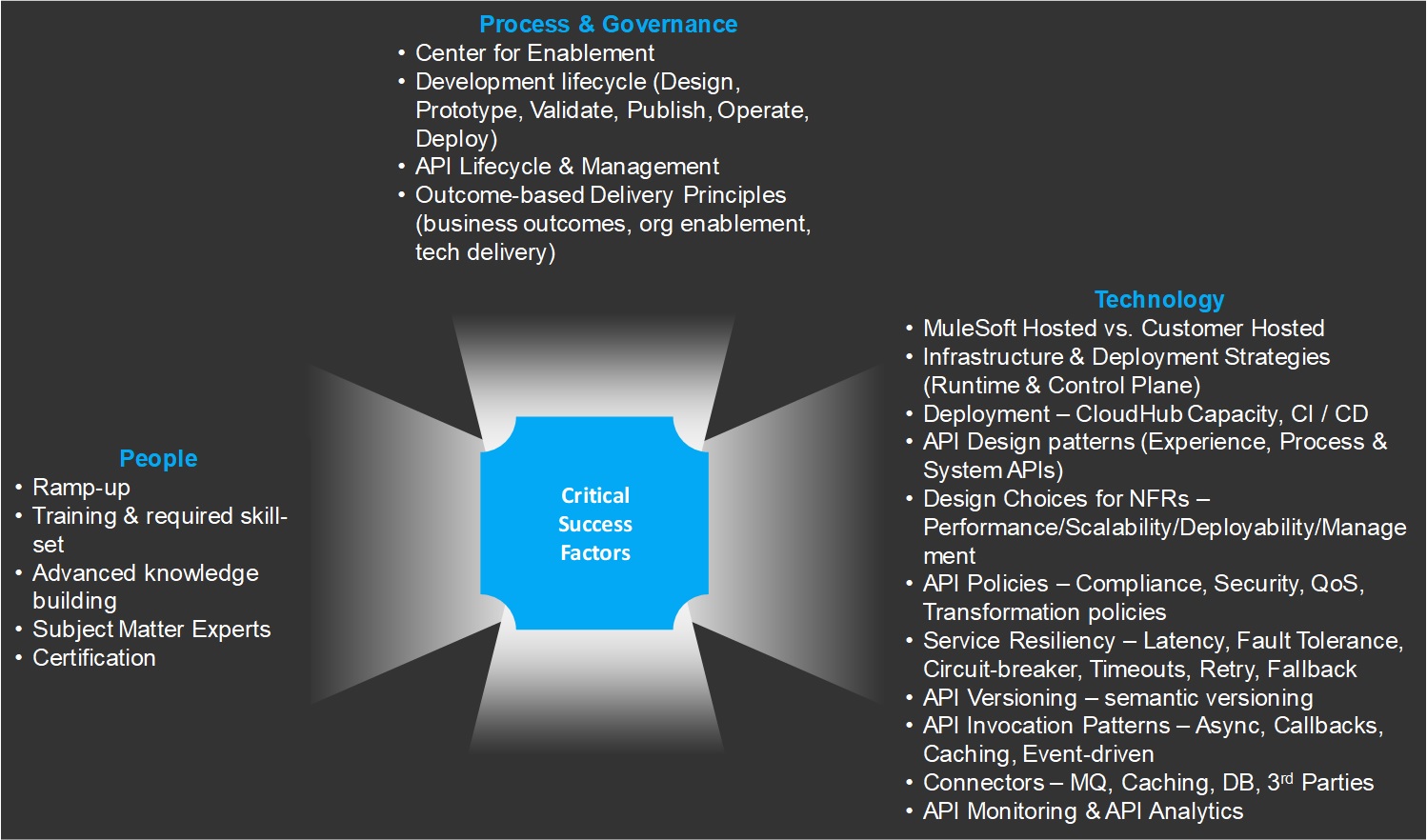As an enterprise API management solution, MuleSoft has been consistently recognized as a leader by research firms like Gartner (click here for 2020 report). It has built-in & out-of-the-box capabilities to get your journey accelerated towards Enterprise API development strategy in your organization. Furthermore, having an API Strategy with defined critical success factors helps to measure success in the future.
As applicable to most of the organizations, there are three key dimensions – People, Process & Governance, and Technology – which can be used to compartmentalize critical success factors. A consolidated view with critical success factors applying these three dimensions have been depicted below:
People
| Critical Success Factor | Description |
|---|---|
| Ramp-up | Ensure that developers and architects have a structured ramp-up plan with ramp-up effectiveness as a measurable metric |
| Training & required skill-set | Ensure that focused area & capabilities (MuleSoft) required in your organization is part of traning focus areas and have a measurable output (e.g. design or code artifact) to measure its effectiveness |
| Advanced knowledge building | Identity 20-30% of your API development team to be groomed for advanced knowledge building |
| Subject Matter Experts | Hire/contract or enrich your API management team with 10-20% of MuleSoft experts to apply industry best practices and establish governance |
| Certification | Identify 20-30% of your API development team to get ready for MuleSoft certification. More than certification itself, path of getting certified is important. Click here to get more details on MuleSoft certification. |
Process & Governance
| Critical Success Factor | Description |
|---|---|
| Center for Enablement | Establish de-centralized center for enablement for establishing API governance at organization level and measure success by using API metrics (e.g. Assets published – Exchange, API managed – API Manager, Number of API invocations – Anypoint Monitoring, Number of Clients registered – Exchange, etc.) |
| Development Lifecycle (Design, Prototype, Validate, Publish, Operate, Deploy) | Establish API Development lifecycle using Design Center, Anypoint Studio, API management using API Manager, API prototyping using Exchange, and Publishing using API Exchange |
| API Lifecycle & Management | Establish API Versioning & Deployment Approach |
| Outcome-based Delivery Principles (business outcomes, organization enablement, tech delivery) | Establish business & technology outcomes to be measured and measure your success against those parameters. MuleSoft provides outcome-based delivery as a methodology, which can be leveraged in your organization. |
Technology
| Critical Success Factor | Description |
|---|---|
| MuleSoft Hosted vs. Customer Hosted | Establish deployment strategy for Anytime platform runtime & control plane |
| Infrastructure & Deployment Strategies (Runtime & Control Plane) | Option A – MuleSoft Hosted using AWS Public Cloud Option B – Customer Hosted with manually provisioned on bare metal, VMs, on-premises, in a public or private cloud Option C – Hybrid-deployment Approach |
| Deployment – CloudHub Capacity, CI / CD | Establish Compute Capacity required for CloudHub or On-premises Continuous Integration flow for build & deployment using below pipeline steps: Build, Munits, Package, Store (Artifcatory), Containerize, Test & Deploy |
| API Design patterns (Experience, Process & System APIs) | Establish API layers from less frequently changed APIs (System APIs) to more frequently changed APIs (Experience APIs). Click here for more details on difference between System, Process & Experience APIs. |
| Design Choices for NFRs | Establish API NFRs (Performance, Scalability, Deployability, Management) and apply them using available API policies and deployment configuration. Apply constraints on on throughput, response time, security and reliability. |
| API Policies | Use out-of-the-box API policies made available by MuleSoft (most of them do not require any code change). Establish strategy for enforcing API policies either on API Proxy or directly API implementation or both. |
| Service Resiliency | Establish strategy to be used by API clients: Timeout, Retry, Circuit Breaker, Fallback API invocation, Parallel API invocation, etc. Note that these are pattern to be established by API architect to ensure development team implements using resilience in mind. |
| API Versioning – semantic versioning | Establish & use API versioning techniques made available by MuleSoft. Read more by clicking here. |
| API Invocation Patterns | Establish API clients invocation patterns during design phase for building a de-coupled system and use invocation patterns (Async, Callbacks, Caching, Event-driven) |
| Deployment – CloudHub Capacity, DevOps – CI / CD | Use auto-scaling feature to avoid estimation. Read more by clicking here about MuleSoft Autoscaling. |
| Connectors (MQ, Caching, DB, 3rd Parties & more) | MuleSoft provides numerous connectors – establish an organization strategy on connectors be used for often than custom coding. Read more details on available connectors by clicking here. |
| API Monitoring & API Analytics | Establish strategy of either using in-built MuleSoft Anypoint Monitoring or integrate existing application performance montioring solution like DynaTrace, New Relic etc. |
In essence, the journey to establish an API-driven organization starts by choosing the right product (such as MuleSoft). Furthermore, it is an important aspect to measure critical success factors for the effectiveness of people, process, and technology practices in an API-led organization.


